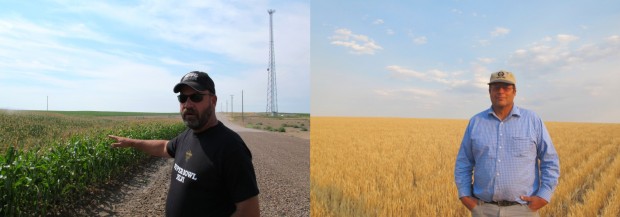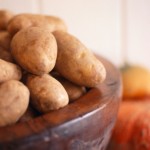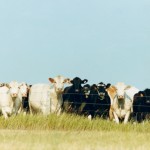One Drought, Two Idaho Farmers, Very Different Outcomes
Some of Idaho’s most fertile farm ground has been hit by the drought that’s crippling crops nationwide. Farmers who have deep wells and irrigation are faring well. Those who don’t aren’t. It’s one indication of the very different economics of dry-land and irrigated farming.
Not long ago, farmer Hans Hayden stood at the edge of his drought-withered spring wheat field, and described how it should look at this time of year. “It should be twice this tall,” he said. “It would actually look like a wheat field! At this point in time it kind of looks like a desert.”
Not far away, farmer Jim Tiede marveled at his own beautiful crop. Looking out at it, Tiede had a different note in his voice: one of barely contained glee. “You spend all year babying it and pampering it and watering it and fertilizing it just right and now’s the payday!” he said, chuckling.
Tiede’s farm sits over the Snake River Aquifer. He can pump 3,000 gallons of water per minute onto his fields of wheat, potatoes, corn and sugar beets. In this year when drought has decimated crops across the country, pushing prices up, that water will make a big difference to Tiede’s bottom line. Hayden has no such luck. He is what’s called a dry-land farmer, one who has no choice but to wait for rain.

Molly Messick / StateImpact Idaho
Stan Gortsema was Power County's extension agent for more than 30 years.
Here’s the thing about Hans Hayden and Jim Tiede: they make their livings on southeast Idaho’s fertile farm ground. It’s land passed down from their homesteader grandfathers. But the similarities more or less stop there.
Stan Gortsema spent 34 years as the extension agent in Power County, where Hayden and Tiede farm. “It’s called the opportunity you have in water,” he exclaims.
“If you can grow higher income crops than grain, such as field corn, sugar beets, potatoes – the dry farmer doesn’t have that option. His option is if he wants to farm, he can grow grain, he can grow safflower, or he can have a summer fallow field.”
An irrigated farmer has more options, but his costs go up, too. Jim Tiede estimates he spent $300 per acre to grow wheat this year. For dry-land farmer Hans Hayden, the per-acre cost was much lower: about $80.
In a normal year, even though Tiede’s fields are more productive, his high costs mean he breaks even on wheat. He grows it only because he needs it in his crop rotation. Hayden, on the other hand, usually makes a pretty good profit. For him, this is the rare year when that won’t be the case. But Tiede’s wheat will pay him well, because prices are high.
At the General Mills grain elevators in American Falls, giant trucks full of freshly harvested wheat line up every which way waiting to unload. Inside, superintendent John Peake looks on as grain pours from the back of an idling semi.

Molly Messick / StateImpact Idaho
John Peake examines wheat as its delivered to the grain elevators in the Power County town of American Falls.
“We dumped 325 trucks yesterday which is roughly 175,000 bushels,” he says. “That’s a lot of wheat.”
He says the drought that’s hurt dry-land farmers like Hans Hayden won’t have a big impact on local production. Peake will still send out railcar after railcar, each holding 220,000 pounds of wheat. But he knows some farmers won’t fare well.
“I mean, being a dry-land farmer in southeast Idaho is a tough deal,” Peake says. “It was a windy year, it was hot early. It was just a tough year to be a dry-land farmer.”
What everyone here will tell you, though, is that irrigated farmers aren’t immune. They have enough water this year thanks to the heavy snowfall that came the winter before last. It filled reservoirs to their brims. But if the dry conditions keep up, stores could run low. And if that happens, Hans Hayden says, irrigated farmers, with their big upfront costs, will be in a tough position. He and other dry-land farmers will have less at risk.
“We’re playing the penny slots and they’re playing the $100 poker game,” Hayden says. “We both can win and we both can lose. They just make a lot of money when they make it and they lose a lot of money when they lose it, because there’s so much more money involved.”
And that, Hayden says, is one more reason why he’s glad to be a dry-land wheat farmer, even in a bad, hot year like this one.
This is the second story in a two-part series. To listen to the first piece, click here.



